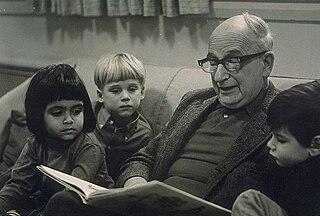
H. A. Rey was a German-born American illustrator and author, known best for the series of children's picture books that he and his wife Margret Rey created about Curious George.

Margret Elizabeth Rey was a German-born American writer and illustrator, best known for the Curious George series of children's picture books that she and her husband H. A. Rey created from 1939 to 1966.
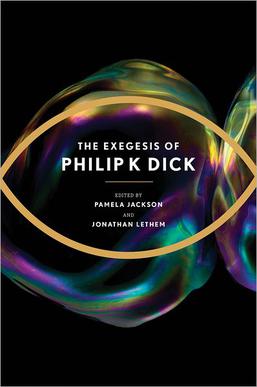
The Exegesis of Philip K. Dick is a 2011 non-fiction book containing the published selections of a journal kept by the science fiction writer Philip K. Dick, in which he documented and explored his religious and visionary experiences. Dick's wealth of knowledge on the subjects of philosophy, religion, and science inform the work throughout.

Curious George is a fictional monkey who is the title character of a series of popular children's picture books written and illustrated by Margret and H. A. Rey. Various media, including films and TV shows, have been based upon the original book series.
Houghton Mifflin Harcourt is an American publisher of textbooks, instructional technology materials, assessments, and reference works. The company is based in the Boston Financial District. It was formerly known as Houghton Mifflin Company, but it changed its name following the 2007 acquisition of Harcourt Publishing. Prior to March 2010, it was a subsidiary of Education Media and Publishing Group Limited, an Irish-owned holding company registered in the Cayman Islands and formerly known as Riverdeep. In 2022, it was acquired by Veritas Capital, a New York-based private-equity firm.
Evolutionary neuroscience is the scientific study of the evolution of nervous systems. Evolutionary neuroscientists investigate the evolution and natural history of nervous system structure, functions and emergent properties. The field draws on concepts and findings from both neuroscience and evolutionary biology. Historically, most empirical work has been in the area of comparative neuroanatomy, and modern studies often make use of phylogenetic comparative methods. Selective breeding and experimental evolution approaches are also being used more frequently.
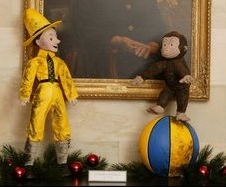
A pet monkey is a monkey kept as a pet. The practice of keeping monkeys as pets is controversial.

Curious George is a 2006 animated adventure film based on the book series written by H. A. Rey and Margret Rey. It was directed by Matthew O'Callaghan, written by Ken Kaufman and produced by Ron Howard, David Kirschner, and Jon Shapiro. Featuring the voices of Will Ferrell, Drew Barrymore, David Cross, Eugene Levy, Joan Plowright, and Dick Van Dyke, it tells the story of how the Man with the Yellow Hat, a tour guide at a museum, first befriended a curious monkey named George and started going on adventures with him around the city while attempting to save the museum from closure.

Curious George Flies a Kite is a children's book written for beginning readers by Margret Rey, illustrated by H. A. Rey, and published by Houghton Mifflin in 1958. It is the fifth book in the original Curious George series and the only one the Reys did not write together.
Helen Lester is an American children's writer, best known for her character Tacky the Penguin in many of her children's stories.

Curious George Cottage was the summer home of H.A. Rey and Margret Rey, creators of the Curious George series of children’s books, located in Waterville Valley, New Hampshire.

Curious George is a children's book written and illustrated by Margret Rey and H. A. Rey, and published by Houghton Mifflin in 1941. The first book in the Curious George series, it tells the story of an orphaned monkey named George and his adventures with the Man with the Yellow Hat. For 80 years, it has sold over 25 million copies, and has been translated into various different languages such as Japanese, French, Afrikaans, Portuguese, Swedish, German, Chinese, Danish, and Norwegian. It is also in the Indie Choice Book Awards Picture Book Hall of Fame and has been the subject of scholarly criticism.

Curious George Takes a Job is a children's book written and illustrated by Margret Rey and H. A. Rey and published by Houghton Mifflin in 1947. It is the second of the Curious George books and tells the story of George taking a job as a window washer.
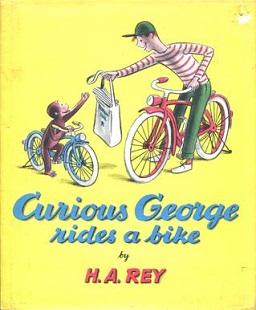
Curious George Rides a Bike is a children's book written and illustrated by Margret Rey and H. A. Rey and published by Houghton Mifflin in 1952. It is the third book of the original Curious George series and tells the story of George's new bicycle and his experiences performing with an animal show.
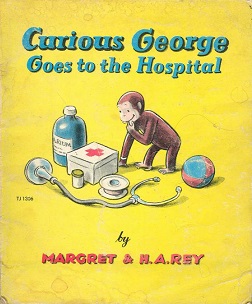
Curious George Goes to the Hospital is a children's picture book written and illustrated by Margret Rey and H. A. Rey and published by Houghton Mifflin in 1966. It is the seventh and final book in the original Curious George series, and tells the story of George's experiences in a hospital after swallowing a jigsaw puzzle piece.

Curious George 2: Follow That Monkey! is a 2009 American animated comedy film based on the children's stories by H.A. Rey and Margret Rey. It is a sequel to the 2006 film Curious George. It was originally titled Curious George 2: Monkey on the Run. It was released straight to DVD in the United States and theatrically in Denmark, Sweden, and Iceland.

Curious George Gets a Medal is a George book written and illustrated by Margret Rey and H. A. Rey and published by Houghton Mifflin in 1957. It is the fourth book in the original Curious George series, and tells the story of George's flight into space. The story was published only weeks before the Soviets launched Sputnik II and Rey wanted to share his interests in space travel with children.

Curious George Learns the Alphabet is a children's book written and illustrated by Margret Rey and H. A. Rey and published by Houghton Mifflin in 1963. It is the sixth book in the original Curious George series.

Curious George is an American media franchise based on the book series of the same name by H. A. Rey and Margret Rey. The series began with the 2006 theatrical release of Curious George. The film's success led it to receiving direct-to-video sequels, a television series as well as a video game.
Mapuche slavery was commonplace in 17th-century Chile and a direct consequence of the Arauco War. When Spanish conquistadors initially subdued the indigenous inhabitants of Chile, there was no slavery but a form of involuntary servitude called encomienda. However, this form of forced labour was harsh and many Mapuche would end up dying in the Spanish gold mines during the 16th century.














